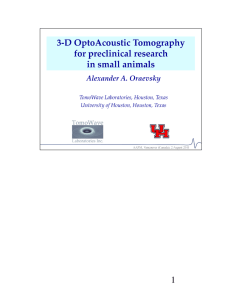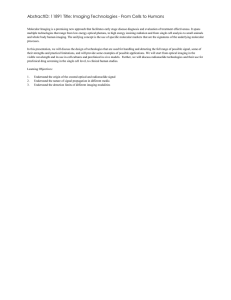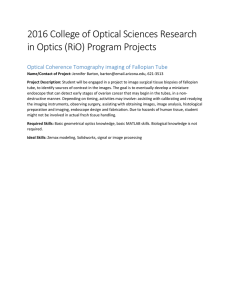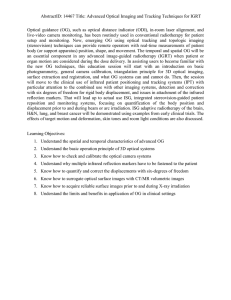Diffuse optical tomography with physiological and spatial a priori
advertisement
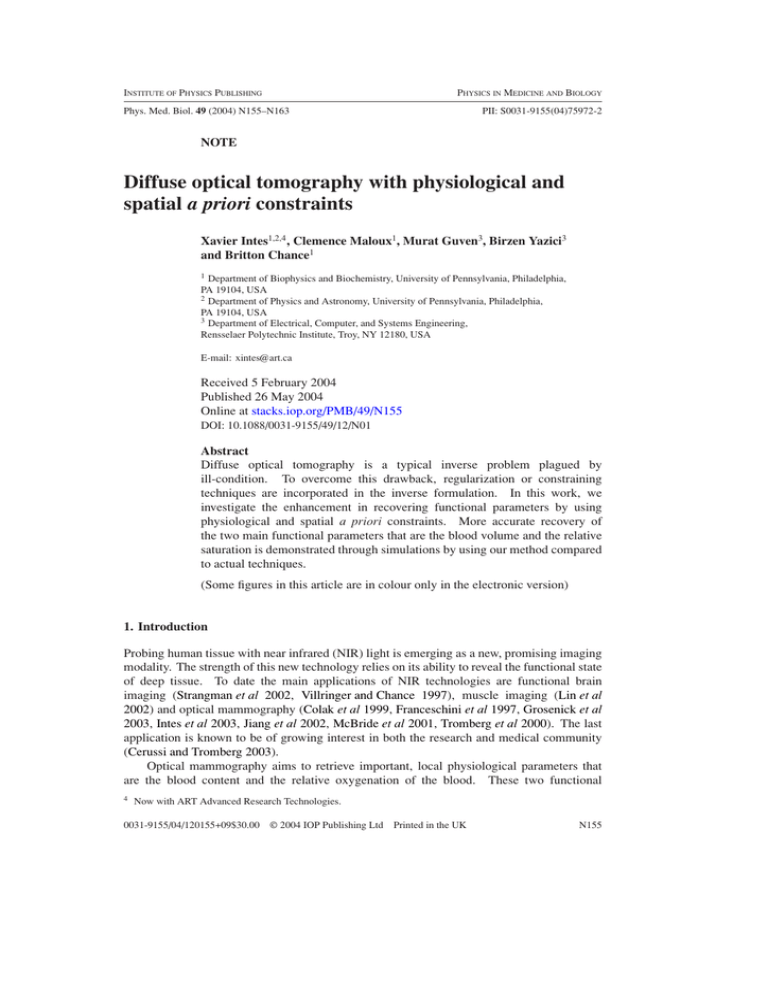
INSTITUTE OF PHYSICS PUBLISHING
PHYSICS IN MEDICINE AND BIOLOGY
Phys. Med. Biol. 49 (2004) N155–N163
PII: S0031-9155(04)75972-2
NOTE
Diffuse optical tomography with physiological and
spatial a priori constraints
Xavier Intes1,2,4 , Clemence Maloux1, Murat Guven3, Birzen Yazici3
and Britton Chance1
1 Department of Biophysics and Biochemistry, University of Pennsylvania, Philadelphia,
PA 19104, USA
2 Department of Physics and Astronomy, University of Pennsylvania, Philadelphia,
PA 19104, USA
3 Department of Electrical, Computer, and Systems Engineering,
Rensselaer Polytechnic Institute, Troy, NY 12180, USA
E-mail: xintes@art.ca
Received 5 February 2004
Published 26 May 2004
Online at stacks.iop.org/PMB/49/N155
DOI: 10.1088/0031-9155/49/12/N01
Abstract
Diffuse optical tomography is a typical inverse problem plagued by
ill-condition. To overcome this drawback, regularization or constraining
techniques are incorporated in the inverse formulation. In this work, we
investigate the enhancement in recovering functional parameters by using
physiological and spatial a priori constraints. More accurate recovery of
the two main functional parameters that are the blood volume and the relative
saturation is demonstrated through simulations by using our method compared
to actual techniques.
(Some figures in this article are in colour only in the electronic version)
1. Introduction
Probing human tissue with near infrared (NIR) light is emerging as a new, promising imaging
modality. The strength of this new technology relies on its ability to reveal the functional state
of deep tissue. To date the main applications of NIR technologies are functional brain
imaging (Strangman et al 2002, Villringer and Chance 1997), muscle imaging (Lin et al
2002) and optical mammography (Colak et al 1999, Franceschini et al 1997, Grosenick et al
2003, Intes et al 2003, Jiang et al 2002, McBride et al 2001, Tromberg et al 2000). The last
application is known to be of growing interest in both the research and medical community
(Cerussi and Tromberg 2003).
Optical mammography aims to retrieve important, local physiological parameters that
are the blood content and the relative oxygenation of the blood. These two functional
4
Now with ART Advanced Research Technologies.
0031-9155/04/120155+09$30.00 © 2004 IOP Publishing Ltd Printed in the UK
N155
N156
X Intes et al
parameters are known to provide a means of discriminating between healthy and diseased
tissues. The blood content relates to the angiogenesis level of the tumourous mass, and the
relative oxygenation to its hypermetabolic state. These two functional signatures correlate to
malignancy.
Pre-clinical data strengthen these assumptions. However, difficulties arise due to the
specific nature of the light propagation. In this spectral window, the light is strongly
diffused leading to a relatively poor resolution for thick tissue investigation. Also, the
breast is by nature a heterogeneous organ with a complex spatial distribution of optical
relevant chromophores. In the NIR spectral range, four chromophores are accountable for
the absorption (Cerussi et al 2001). These chromophores are the oxy- ([HbO2]), deoxyhaemoglobin ([Hb]), the water ([H2O]) and the lipids ([Li]). The first two chromophores are
providing an insight into the tissue functional state. The last two chromophores are linked to
the structural architecture of the breast. The spatial distribution and the relative concentrations
of these chromophores are patient dependent and even more can vary over time in the same
patient due to hormonal regulation (Chance 2001, Cubeddu et al 2000, Durduran et al 2002,
Shah et al 2001, Srinivasan et al 2003).
To enhance diffuse optical tomography (DOT) performances, researchers have proposed
fusing optical techniques with other medical imaging modality. Magnetic resonance imaging
(MRI) is the perfect candidate for optical co-registration (Brooksby et al 2003, Guven et al
2004, Ntziachristos et al 2002, Pei et al 1999, Pogue and Paulsen 1998). MRI provides high
spatial resolution maps of the breast optical structure that are relevant to the water and lipid
distribution. Moreover, MRI can provide a means to estimate the concentration of these two
structural chromophores (Merrit et al 2003). In this paper, we investigate the first step towards
incorporating physiological and spatial a priori information derived from MRI.
2. Methods
2.1. Forward model
The propagation of NIR light in tissue is well modelled by the diffusion equation. In the case
of heterogeneity, the diffusion equation can be solved by a perturbative approach (O’Leary
1996). In this work, we have used the Rytov approximation approach. In the case of DOT,
multiple source–detector pairs are used. The medium under consideration is sampled in voxels
and the problem can be written as a matrix equation (Arridge 1999), i.e.:
W11 . . . W1n
δµa (r1 )
(rs1 , rd1 )
..
..
.. × ..
..
(1)
= .
.
.
. .
(rsm , rdm )
δµa (rn )
Wm1 . . . Wmn
where (rsi , rdi ) is the diffuse perturbative phase for the ith source–detector pair, Wij (O’Leary
1996) is the weight for the jth voxel and the ith source–detector pair and δµa (rj ) is the
differential absorption coefficient of the jth voxel. We limited our problem to image the
absorption coefficient. Boundary conditions for semi-infinite geometries and slab geometries
are derived using the extrapolated boundary condition and the image source technique
(Haskell et al 1994).
2.2. Functional imaging
The estimation of the absorption coefficient at several wavelengths enables the provision of
spatial maps of the targeted chromophores. In the case of the breast, the four chromophores
of potential diagnostic interest are the oxy- and deoxy-haemoglobin, the water and the lipid.
DOT constrained with physiological a priori
N157
The concentrations of these breast constituents are linearly related to the absorption values
through the linear system:
λ1
λ1
λ1
λ1
δ[Hb](rj )
εHb εHbO
εHλ12 O εLi
δµa (rj )
2
..
..
..
..
..
δ[HbO2 ](rj )
(2)
= .
.
.
.
. × δ[H O](r )
2
j
λp
λp
λp
λp
λp
δµa (rj )
εHb εHbO2 εH2 O εLi
δ[Li](rj )
where δµλk
a (rj ) is the differential absorption coefficient at the kth wavelength λk and for the
jth voxel, εCλk is the extinction coefficient of the Cth chromophore at the kth wavelength and
δ[C](rj ) is the differential concentration of the Cth chromophore for the jth voxel.
Solving this linear system on a voxel basis for a spectral set of absorption distributions
gives the functional maps required for diagnostic purposes. We will refer to this approach as
‘indirect imaging’ through this paper.
Recently, to overcome the burden and minimize the systematic errors due to the
ill-condition of both inverse problems, a method aiming at directly imaging the functional
parameters has been proposed (Durduran et al 2001). This method takes advantage of the
linear relationship described previously and formulates the inverse problem as
λ1
(rs1 , rd1 )
..
λ1
λ1
λ1 λ1
.
εHb
W λ1 εHbO
W λ1 εHλ12 O W λ1 εLi
W
2
λ1 (r , r )
δ[Hb](rj )
sm dm
λ2
λ2
λ2
λ2
λ2
λ2
λ2
λ2
εHb W
εHbO2 W
εH2 O W
εLi W δ[HbO ](r )
2
j
..
=
..
..
..
.. ×
.
δ[H2 O](rj ) . (3)
.
.
.
.
λp
(rs1 , rd1 )
δ[Li](rj )
λp
λp
λp
λp
λp
λp
λp
εHbO2 W
εH2 O W
εLi W λp
εHb W
..
.
λp
(rsm , rdm )
This new linear system is poorly conditioned and great care should be taken during the
pre-conditioning of this sensitivity matrix. In our case, we used an average column scheme
(Pei et al 2001) applied to each sub-matrix of the kernel as written in (3). This specific preconditioning scheme led to the most accurate reconstructions. We will refer to the scheme
expressed in (3) as ‘direct imaging’ through this document.
The functional parameters that we are interested in are the blood volume:
[BV] = [Hb] + [HbO2 ]
(4)
and the relative saturation:
[SaO2 ] =
[HbO2 ]
.
[Hb] + [HbO2 ]
(5)
2.3. Bayesian framework
Due to the ill-posed and/or underdetermined nature of the DOT problem, the solution of the
inverse problem is not typically robust. One avenue to overcome this difficulty is to incorporate
a priori information constraining the space of unknowns.
The Bayesian approach provides a natural framework to incorporate prior information.
Guven et al (2004) proposed an algorithm based on the Bayesian framework with a spatially
varying a priori probability density function extracted from MRI anatomical maps. Here we
propose to extend this algorithm to a spatial physiological prior. The full derivation of the
theoretical developments for the algorithm is presented in detail in Guven et al (2004) and we
N158
X Intes et al
follow herein the same mathematical expressions. We present in this investigation only the
salient features of the theoretical approach that are relevant to this work.
The available high-resolution anatomical image is segmented into sub-images that
represent major tissue types (typically: parenchyma, glandular and tumour). Prior probability
density function of the image is formulated in such a way that each sub-image is assigned a
mean value that need not be equal to its actual optical value; and a ‘confidence level’ is defined
in the form of an image variance formulation to allow local variations within sub-images. As
a consequence, the overall formulation of the prior information becomes spatially varying,
which is specific to the image of interest. Maximum a posteriori (MAP) estimate of the image
is formed based on the formulation of the image’s probability density function
x̂MAP = arg max{log p(y|x) + log p(x)}
x
(6)
where p(y|x) is the data likelihood function and p(x) is the probability density function of the
corresponding image. An ‘alternating minimization’ algorithm, which sequentially updates
the unknown parameters, is used to solve the resulting optimization problem.
For our purposes, the probability density function of the ith sub-image, as defined in the
spatial prior, becomes
1
1
2
i = 1, 2, . . . , M (7)
exp
−
x
−
C
p(xi |σi ) = i
i
N /2
2σi2
2π σi2 i
where M is the number of sub-regions and Ni is the number of voxels in the ith sub-image,
xi is the unknown sub-image, C i is the assigned chromophore mean concentration and σi2
the single variance, which is an unknown parameter (estimated during the solution). To
incorporate the confidence level into the statistical reconstruction procedure, the sub-image
variances are expressed as
1
1
2
i = 1, 2, . . . , M
(8)
exp
−
σ
−
σ̄
p(σi ) = i
i
N /2
2γi2
2π γi2 i
where γi is the variance and σ̄i the mean value of σi . These two last parameters are a priori
defined by the user. Thus the confidence level incorporated into the statistical reconstruction
procedure is defined on the chromophores concentration. Hence, physiological priors are
implicitly defined and allow constraining the reconstruction in physiologically meaningful
ranges.
2.4. Measurement generation
Measurements were obtained by solving the frequency-domain diffusion equation with a finite
difference approach (FDM). We restricted our simulations to a two-dimensional (2D) geometry
for computational efficiency and to a continuous wave data set type. The slab thickness was
6 cm simulating a soft compressed breast. We placed nine sources on one side of the slab and
nine detectors on the other side, both evenly stretched along 8 cm (cf figure 1). Two square
inclusions of 1 cm2 were simulated in this model.
The functional properties were chosen to mimic typical values encountered in the human
breast. Table 1 summarizes the functional parameters simulated.
The optical models were computed for six wavelengths to replicate the spectral
information gathered by our time resolved instrument that performs co-registration with MRI
(Intes et al 2002). The subsequent optical properties are compiled in table 2. The FDM
computations were performed with a 1 mm mesh resolution. The sources and detectors were
positioned 2 cm away from the edges to avoid any boundary effects.
DOT constrained with physiological a priori
N159
µa (cm-1)
sources
0.1
1 cm
6 (cm)
0.08
0.06
0.04
5cm
0.02
detectors
12 (cm)
Figure 1. Optical model used for the simulations. The optical properties displayed here correspond
to λ = 750 nm.
Table 1. Functional parameters used to define the optical properties to generate the synthetic
measurements.
BV (mM)
SaO2 (%)
Background
Left object
Right object
0.02
70
0.06
65
0.12
50
Table 2. Optical parameters for the spectral set investigated herein. No [H2O] and [Li] constituents
were used in these simulations for simplicity.
690
750
780
805
830
850
µs (cm−1)
9.268
8.386
8.000
7.646
7.425
7.216
µa (cm−1)
µLeft
(cm−1)
a
0.016
0.054
0.016
0.050
0.016
0.050
0.016
0.049
0.018
0.053
0.019
0.056
0.140
0.115
0.107
0.095
0.100
0.105
bkg.
Right
µa
(cm−1)
3. Results
First, the estimation of the functional parameters simulated is accomplished with a conjugate
gradient descent (CGD) algorithm in the case of indirect imaging without using any kind of
prior. The results are displayed in figure 2.
Then reconstructions using the indirect imaging approach within the Bayesian framework
are provided in figure 3. First, an estimation of the absorption coefficients at the six wavelengths
was performed using spatial a priori information and a conjugate gradient algorithm with the
Polak–Ribiere method (Polak and Ribiere 1969). The absorption coefficients mean values
assigned were the simulated ones with a 30% level of confidence (Guven et al 2004). Then
classical spectroscopy was performed on the resulting optical maps using the linear system
of (3) reduced to [HbO2] and [Hb] concentrations. Last, the results using physiological and
spatial a priori information are depicted in figure 4. The chromophore concentration means
assigned were the exact ones with a 30% level of confidence.
The functional quantitative values retrieved from each case and for the relevant region of
interest are summarized in table 3.
N160
X Intes et al
0
0
(a)
(b)
2
2
4
4
6
6
0
2
0.03
4
0.04
6
8
0.05
10
0.06
0
12
0.07
2
0
4
20
6
40
8
10
60
12
80
100
Figure 2. (a) Blood volume (mM) reconstructions and (b) saturation estimates (%) in the case of
classical indirect imaging.
0
0
(a)
(b)
2
2
4
4
6
6
0
2
4
6
0.02
0.04
0.06
0.08
0.02
0.04
0.06
0.08
8
10
0.1
0.1
12
0
0.12
0.14
0.12
0.14
00
2
10
20
20
4
6
40
40
30
50
8
60
60
10
70
80
80
12
90
100
100
Figure 3. (a) Blood volume (mM) reconstructions and (b) saturation estimates (%) in the case
of Bayesian indirect imaging. The assigned mean values of the absorption correspond to the true
absorption values with a 30% level of confidence.
0
0
(a)
2
2
4
4
(b)
6
6
0
2
4
6
0.02
0.04
0.06
0.08
0.02
0.04
0.06
0.08
8
10
0.1
0.1
12
0.12
0.12
0
00
2
10
20
20
4
30
6
40
40
50
8
60
60
10
70
80
80
12
90
100
100
Figure 4. (a) Blood volume (mM) reconstructions and (b) saturation estimates (%) in the case of
Bayesian direct imaging. The assigned mean values correspond to the true concentration values
with a 30% level of confidence.
4. Discussion
In all the cases investigated herein, the two inclusions were reconstructed. As expected,
the incorporation of spatial a priori information increased the image resolution. In the
case of indirect imaging without a priori information the two inclusions are elongated and
thus the contrast is diluted. This fact is reflected in the estimation of the blood volume that is
underestimated for both objects (∼35% lower estimate). When a priori anatomical information
is incorporated within the Bayesian framework, the estimation of the blood volume is more
DOT constrained with physiological a priori
N161
Table 3. Functional parameters recovered with the three approaches and for the three different
functional areas. The values proposed here correspond to the mean value of the entire ROI defined
as the a priori spatial masks. [BV] in mM and [SaO2] in %.
Background
Indirect imaging
Bayesian indirect imaging
Bayesian direct imaging
Left object
Right object
[BV]
[SaO2]
[BV]
[SaO2]
[BV]
[SaO2]
0.023
0.019
0.020
71
72.46
69.95
0.042
0.065
0.061
67
63.73
65.27
0.075
0.122
0.127
57
55.44
50.02
accurate falling to less than 10% of misestimation in the worse case (1% in the best case).
Moreover, when direct imaging is applied in this framework, the two objects are recovered
respectively within 1% and 5% for the left and right objects compared to 8% and 2% in the
case of indirect imaging.
The enhancement of the technique is even more notable when SaO2 is considered. The
recovery of SaO2 is then more robust but also less prone to artefacts. Especially in the case of
the right object, the recovery of the SaO2 is superior to the direct imaging approach within the
Bayesian framework.
Overall, these simulations highlight the potential of our approach to provide more accurate
maps of the relevant functional diagnostic parameters. These simulations were limited to
[BV] and SaO2 recovery. The approach is easily extensible to [H2O] and [Li]. Especially, the
ability of MRI to provide spatial concentration of these chromophores for the assigned prior
strengthens our approach (Merrit et al 2003).
The mean values of the chromophores and the anatomical a priori information are defined
by the user. The anatomical maps are provided by the structural MRI maps (such as T1)
and tumour delineation could be performed by Gd enhanced MRI. Moreover, estimation of
the water, lipid and BV concentrations are feasible with MRI. These values can be used for
the mean concentration priors. Also, an alternative is to obtain these values with a simple
algorithm such as diffuse optical spectroscopy (Ntziachristos et al 2002). The paradigm of
uniform concentrations for a certain tissue type is overcome in the Bayesian formulation by
defining a level of confidence. These effects of confidence ensure the reconstructions are in a
physiologically meaningful range and allow the recovery of heterogeneous concentration in a
certain kind of tissue type. Such heterogeneous estimates are visible in figures 3 and 4.
This last point is of paramount importance in the case of MRI-assisted DOT. The contrast
provided by MRI is not expected to be exactly congruent with the optical contrast. Allowing
heterogeneous bounded reconstructions within each sub-image compensates for discrepancies
between both modalities.
5. Conclusion
We reported in this work our first step towards incorporating physiological and spatial
a priori information derived from MRI to assist DOT. Better estimates of the main functional
parameters that are [BV] and [SaO2] were achieved. More accurate functional maps can lead
to an increase of the sensitivity and specificity of optical techniques by incorporating structural
contrasts that are known to occur in breast cancer. Moreover, these accurate estimations will
be important for application such as therapy monitoring (Zhang et al 2003).
This preliminary work will be continued with experimental validation and incorporated
in our ongoing clinical trial at the University of Pennsylvania. Also, the investigation will be
N162
X Intes et al
extended to the potential of our approach to recover exogenous contrast agent concentrations.
New classes of contrast agents that are tumour specific (Licha 2002) and/or compatible with
both technologies (Josephon et al 2002) will be investigated. The inclusion of spatial and
temporal a priori information is expected to provide a better estimate of the fluorochrome
concentration but also to probe physiological parameters such as extravasation (Intes et al
2003, Cuccia et al 2003) that are still elusive with DOT for thick tissue investigation.
Acknowledgments
XI and BC acknowledge partial support from the National Institute of Health grant no
CA 87046.
References
Arridge S 1999 Optical tomography in medical imaging Inverse Problems 15 R41–R93
Brooksby B, Dehghani H, Pogue B and Paulsen K 2003 Near-infrared tomography breast image reconstruction
with a priori structural information from MRI: algorithm development for reconstructing heterogeneities IEEE
J. Sel. Top. Quantum Electron. 9 199–209
Cerussi A, Berger A, Bevilacqua F, Shah N, Jakubowski D, Butler J, Holcombe R and Tromberg B 2001 Sources of
absorption and scattering contrast for near-infrared optical mammography Acad. Radiol. 8 211–8
Cerussi A and Tromberg B 2003 Optical mammography inches closer to the clinics Biophotonics 38–42
Chance B 2001 Near-infrared optical spectroscopy characterizes breast tissue hormonal and age status Acad. Radiol.
8 209–10
Colak S, van der Mark M, Hooft G, Hoogenraad J, van der Linden E and Kuijpers F 1999 Clinical optical tomography
and NIR spectroscopy for breast cancer detection IEEE J. Sel. Top. Quantum Electron. 5 1143–58
Cubeddu R, D’Andrea C, Pifferi A, Taroni P, Torricelli A and Valentini G 2000 Effects of the menstrual cycle on the
red and near-infrared optical properties of the human breast Photochem. Photobiol. 72–73 383–91
Cuccia D, Bevilacqua F, Durkin A, Merritt S, Tromberg B, Gulsen G, Yu H, Wang J and Nalcioglu O 2003 In vivo
quantification of optical contrast agent dynamics in rat tumors by use of diffuse optical spectroscopy with
magnetic resonance imaging coregistration Appl. Opt. 42 2940–50
Durduran T, Choe R, Culver J, Zubkov L, Holboke M, Giammarco J, Chance B and Yodh A G 2002 Bulk optical
properties of healthy female breast tissue Phys. Med. Biol. 47 2847–61
Durduran T, Giammarco J, Culver J, Choe R, Zubkov L, Holboke M, Intes X, Nioka S, Chance B and Yodh A
2001 Utilizing a priori spectral knowledge in diffuse optical tomography United Engineering Foundation Conf.
Advances in Optics for Biotechnology, Medicine and Surgery VII
Franceschini M, Moesta K, Fantini S, Gaida G, Gratton E, Jess H, Mantulin W, Seeber M, Schlag P and
Kaschke M 1997 Frequency-domain techniques enhance optical mammography: initial clinical results Proc.
Natl Acad. Sci. USA 6468–73
Grosenick D, Moesta T, Wabnitz H, Mucke J, Stroszcynski C, Macdonald R, Schlag P and Rinnerberg H 2003
Time-domain optical mammography: initial clinical results on detection and characterization of breast tumors
Appl. Opt. 42 3170–86
Guven M, Yazici B, Intes X, Maloux C and Chance B 2004 Three-dimensional diffuse optical tomography with
a priori anatomical information J. Biomed. Opt. submitted
Haskell R, Svaasand L, Tsay T T, Feng Tc, McAdams M and Tromberg B 1994 Boundary conditions for the diffusion
equation in radiative transfer J. Opt. Soc. Am. A 11 2727–41
Intes X, Yu J, Yodh A G and Chance B 2002 Development and evaluation of a multi-wavelength multi-channel time
resolved optical instrument for NIR/MRI mammography co-registration Proc. IEEE 28th Annual Northeast
Bioengineering Conf. (IEEE Cat. No.02CH37342) pp 91–2
Intes X, Ripoll J, Chen Y, Nioka S, Yodh A and Chance B 2003 In vivo continuous-wave optical breast imaging
enhanced with Indocyanine Green Med. Phys. 30 1039–47
Jiang H, Iftimia N, Eggert J, Fajardo L and Klove K 2002 Near-infrared optical imaging of the breast with model-based
reconstruction Acad. Radiol. 9 186–94
Josephon L, Kircher M, Mahmood U, Tang Y and Weissleder R 2002 NIR fluorescent nanoparticles as combined
MR/optical imaging probes Bioconjug. Chem. 13 554–60
Licha K 2002 Contrast agents for optical imaging Top. Curr. Chem. 222 1–29
DOT constrained with physiological a priori
N163
Lin Y, Lech G, Nioka S, Intes X and Chance B 2002 Noninvasive, low-noise, fast imaging of blood volume and
deoxygenation changes in muscles using light-emitting diode continuous-wave imager Rev. Sci. Instrum. 73
3065–74
McBride T, Pogue B, Jiang S, Osterberg U and Paulsen K 2001 Initial studies of in-vivo absorbing and scattering
heterogeneity in near-infrared tomographic breast imaging Opt. Lett. 26 822–4
Merritt S, Gulsen G, Chiou G, Chu Y, Deng C, Cerussi A, Durkin A, Tromberg B and Nalcioglu O 2003 Comparison
of water and lipid content measurements using diffuse optical spectroscopy and MRI in emulsion phantoms
Technol. Cancer Res. Treat. 2 563–9
Ntziachristos V, Yodh A, Schnall M and Chance B 2002 MRI-guided diffuse optical spectroscopy of malignant and
benign breast legions Neoplasia 4 347–54
O’Leary M 1996 Imaging with diffuse photon density waves PhD Thesis University of Pennsylvania
Pei Y, Bao F and Barbour R 1999 Modeling of sensitivity and resolution to an included object in homogeneous
scattering media and in MRI-derived breast maps Opt. Exp. 5 203–19
Pei Y, Graber H and Barbour R 2001 Normalized constraint algorithm for minimizing inter-parameter crosstalk in
DC optical tomography Opt. Exp. 9 97–109
Pogue B and Paulsen K 1998 High-resolution near-infrared tomographic imaging simulations of the rat cranium by
use of a priori magnetic resonance imaging structural information Opt. Lett. 23 1716–8
Polak E and Ribiere G 1969 Note sur la convergence de directions conjuguees Rev. Fr. Inform. Rech. O. 16 35–43
Shah N, Cerussi A, Eker B, Espinoza J, Butler J, Fiskhin J, Hornung R and Tromberg B 2001 Non-invasive functional
optical spectroscopy of human breast tissue Proc. Natl Acad. Sci. USA 98 4420–5
Srinivasan S, Pogue B, Jiang S, Dehghani H, Kogel C, Soho S, Gibson J, Tosteson T, Poplack S and Paulsen K
2003 Interpreting hemoglobin and water concentration, oxygen saturation, and scattering measured in vivo by
near-infrared breast tomography Proc. Natl Acad. Sci. USA 100 12349–54
Strangman G, Boas D and Sutton J 2002 Non-invasive neuroimaging using near-infrared light Biol. Psychiatry 52
679–93
Tromberg B, Shah N, Lanning R, Cerussi A, Espinoza J, Pham T, Svaasand L and Butler J 2000 Non-invasive in vivo
characterization of breast tumors using photon migration spectroscopy Neoplasia 2 26–40
Villringer A and Chance B 1997 Non-invasive optical spectroscopy and imaging of human brain function Trends
Neurosci. 20 435–42
Zhang J, Tu T, Sunar U, Intes X, Nioka S, Zhang Z, Kilger A, Lustig R, Loevner L and Chance B 2003 Application
of I&Q detection system in scouting the curative effect of neck squamous cell carcinoma Proc. SPIE Optical
Tomography and Spectroscopy of Tissue V 4955 575–80
